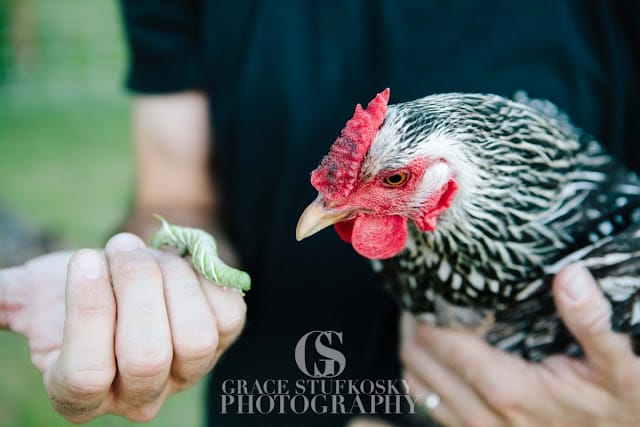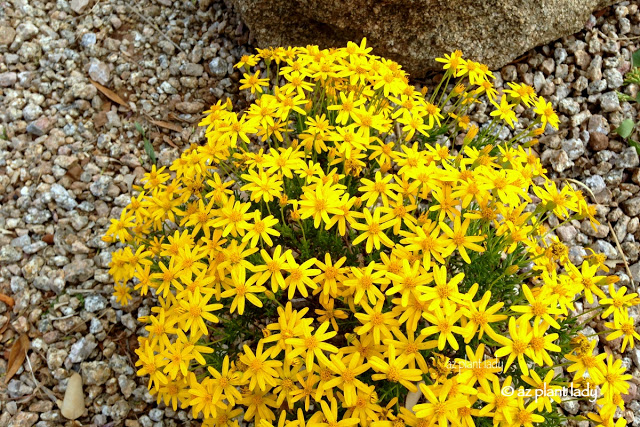The Chicken vs. The Caterpillar

I don’t think that my sister’s chicken has ever seen a caterpillar that large before.
Do you think she will eat it? Or will the caterpillar emerge victorious?
I’ll let you know at the end of this post…
Those of you who have ever grown tomatoes probably recognize this green, horned caterpillar.

If you are not familiar with this green menace, let me introduce you to the ‘tomato hornworm’.
As their name suggests, they love to eat tomatoes and the leaves on their plants.
What you may not know is that also like to eat potato, pepper and eggplants as well.

What is even worse, is that they can be a little hard to find. With their green color, they blend in well with the tomato plants. Tomato hornworms also tend to hide underneath the leaves.
At this point you may be wondering if you have these pesky caterpillars on your tomato plants. How can you tell?
Well, some telltale signs include holes eaten from the leaves and tomatoes. You may also see little green pellets (caterpillar poop) on the leaves.
The only way to know for certain is to go looking for them.

So what do you do if you find out your tomatoes are infested with these caterpillars and how did they get there in the first place?
Well, tomato hornworms grow up into moths who in turn, lay eggs on the underside of tomato leaves. The eggs hatch in about a week and the newly emerged caterpillars start eating non-stop for 4 – 6 weeks.
As if that weren’t enough bad news, as the caterpillars grow larger, they eat more. After about a month on gorging themselves, they drop into the soil where they form a cocoon and transform into a moth who will start the cycle again by laying eggs.
How can you do to get rid of them?
Well, there are a few ways to get rid of them and even help to prevent them in the future.

Tomato hornworm
– The easiest way to get rid of a current infestation of tomato hornworms is to simply pick them off and dunk them into soapy water, which kills them.
– If pulling off large, green caterpillars isn’t your thing, then you can spray them with a product that contains Bt (Bacillus thuringiensis), which infects the stomach of the hornworm, killing it. Bt is safe for animals and plants.
– There are some wasps that will act as parasites to the caterpillars and lay their eggs directly onto them. The eggs hatch and the larvae eat the caterpillar.
Now, I don’t know about you, but I’d rather not have to deal with tomato hornworms at all. So, I am all about prevention.
– In the fall, till the soil around your tomato plants. This will unearth any cocoons that are attempting to overwinter in the soil, which kills them. Do this again in spring, before planting new tomato plants. This is usually 90% effective in getting rid of tomato hornworm cocoons before the moth emerges.
Okay, so back to the chicken, caterpillar face-off…

My sister’s chicken Francie is a ‘naked-neck’ chicken and yes, she is supposed to look that way 😉
It turns out that the chickens were a little put off by the large size of the caterpillars. So, they wouldn’t touch them.
That is until… the caterpillars were cut up into smaller pieces. Then the chickens couldn’t eat them fast enough. (I know, kind of gross, isn’t it?)
**I want to thank my sister, Grace, for her fabulous pictures. You can find out more about her photography, here.

 Noelle Johnson, aka, 'AZ Plant Lady' is a author, horticulturist, and landscape consultant who helps people learn how to create, grow, and maintain beautiful desert gardens that thrive in a hot, dry climate. She does this through her consulting services, her online class Desert Gardening 101, and her monthly membership club, Through the Garden Gate. As she likes to tell desert-dwellers, "Gardening in the desert isn't hard, but it is different."
Noelle Johnson, aka, 'AZ Plant Lady' is a author, horticulturist, and landscape consultant who helps people learn how to create, grow, and maintain beautiful desert gardens that thrive in a hot, dry climate. She does this through her consulting services, her online class Desert Gardening 101, and her monthly membership club, Through the Garden Gate. As she likes to tell desert-dwellers, "Gardening in the desert isn't hard, but it is different."














Hi there, I have to say, having chickens myself I totally would have thought they would have went for it. Mine eat HUGE white grubs. Very informative post, as usual. 🙂 Hey, question for your sister….that looks like a light brahma hen, how do hers do in the southwest heat????? Ours are not doing well (we are in south Texas – San Antonio), and not as heat tolerant as we thought. We lost 3 🙁 I would love to hear what she does…. Thanks in advance.
So, and who is going to pollinate the queen of the night, the datura, and all the other large, white night bloomers? These are important, specialized pollinators (even though I understand that you aren't solely responsible for their production in your tomato garden. Just remember: they aren't all bad, their are part of the big picture. I know that the Manduca cats are loaded with alkaloids, so some birds may avoid them. But I have once seen a cardinal devour a huge sphingid caterpillar…
The caterpillars turn into Sphinx moths, also called hummingbird moths that hover above flowers to pollinate tubular-shaped flowers, including squash, papaya and eggplant.
You might try my friend's technique for eco-friendly management of this caterpillar. She grows 2 sections of tomatoes, one of which she fertilizes heavily. It grows a profusion of leaves, no fruit, and she allows the cats to have these plants instead of her fruiting plants.